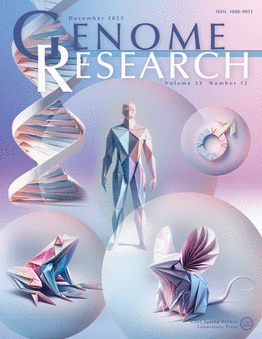利用长线程基因组测序解决自闭症谱系障碍中的复杂重复变异问题
IF 6.2
2区 生物学
Q1 BIOCHEMISTRY & MOLECULAR BIOLOGY
引用次数: 0
摘要
在5%-10%的自闭症谱系障碍(ASD)家族中,可以检测到罕见的或从头开始的结构变异,主要以拷贝数变异的形式存在。虽然使用微阵列或短线程基因组测序(GS)通常可以检测到涉及重复的复杂结构变异,但这些方法经常无法以核苷酸分辨率描述断点的特征,因此需要额外的分子方法进行验证和精细图谱绘制。在这里,我们使用牛津纳米孔技术公司(Oxford Nanopore Technologies)的PromethION长读程基因组测序技术,对五个家族中与ASD分离的涉及大重复的复杂基因组重排(CGRs)进行了表征。我们总共研究了 13 个 CGR 携带者,并以核苷酸分辨率解析了所有断点连接。虽然确定了所有断点,但一个重排的精确基因组结构仍未确定,有三种不同的潜在结构。两个家系的发现包括通过重复重排形成的潜在融合基因,涉及 IL1RAPL1-DMD 和 SUPT16H-CHD8。在来自同一地理区域的两个家系中,发现了涉及 ANK2 的相同重排,这很可能是一个创始变异基因。此外,我们还直接从长读数数据中分析甲基化状态,从而评估重排基因和调控区域的活性。对整个 CGRs 的甲基化调查显示,在影响 CREBBP 基因座的重排中,携带者的甲基化状态异常。总之,我们的研究结果证明了纳米孔测序技术在确定五个无关联家族中与 ASD 相关的 CGRs 方面的实用性,并强调了以基因为中心描述与疾病相关的复杂染色体重排的重要性。本文章由计算机程序翻译,如有差异,请以英文原文为准。
Resolving complex duplication variants in autism spectrum disorder using long-read genome sequencing
Rare or de novo structural variation, primarily in the form of copy number variants, is detected in 5%–10% of autism spectrum disorder (ASD) families. While complex structural variants involving duplications can generally be detected using microarray or short-read genome sequencing (GS), these methods frequently fail to characterize breakpoints at nucleotide resolution, requiring additional molecular methods for validation and fine-mapping. Here, we use Oxford Nanopore Technologies PromethION long-read GS to characterize complex genomic rearrangements (CGRs) involving large duplications that segregate with ASD in five families. In total, we investigated 13 CGR carriers and were able to resolve all breakpoint junctions at nucleotide resolution. While all breakpoints were identified, the precise genomic architecture of one rearrangement remained unresolved with three different potential structures. The findings in two families include potential fusion genes formed through duplication rearrangements, involving IL1RAPL1–DMD and SUPT16H–CHD8. In two of the families originating from the same geographical region, an identical rearrangement involving ANK2 was identified, which likely represents a founder variant. In addition, we analyze methylation status directly from the long-read data, allowing us to assess the activity of rearranged genes and regulatory regions. Investigation of methylation across the CGRs reveals aberrant methylation status in carriers across a rearrangement affecting the CREBBP locus. In aggregate, our results demonstrate the utility of nanopore sequencing to pinpoint CGRs associated with ASD in five unrelated families, and highlight the importance of a gene-centric description of disease-associated complex chromosomal rearrangements.
求助全文
通过发布文献求助,成功后即可免费获取论文全文。
去求助
来源期刊

Genome research
生物-生化与分子生物学
CiteScore
12.40
自引率
1.40%
发文量
140
审稿时长
6 months
期刊介绍:
Launched in 1995, Genome Research is an international, continuously published, peer-reviewed journal that focuses on research that provides novel insights into the genome biology of all organisms, including advances in genomic medicine.
Among the topics considered by the journal are genome structure and function, comparative genomics, molecular evolution, genome-scale quantitative and population genetics, proteomics, epigenomics, and systems biology. The journal also features exciting gene discoveries and reports of cutting-edge computational biology and high-throughput methodologies.
New data in these areas are published as research papers, or methods and resource reports that provide novel information on technologies or tools that will be of interest to a broad readership. Complete data sets are presented electronically on the journal''s web site where appropriate. The journal also provides Reviews, Perspectives, and Insight/Outlook articles, which present commentary on the latest advances published both here and elsewhere, placing such progress in its broader biological context.
 求助内容:
求助内容: 应助结果提醒方式:
应助结果提醒方式:


